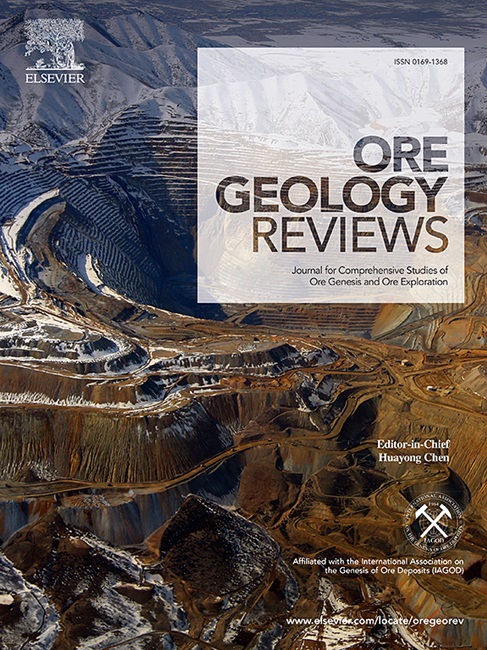富甲烷流体在中温金矿化中的作用——来自华北克拉通柴胡兰子金矿床的启示
IF 3.6
2区 地球科学
Q1 GEOLOGY
引用次数: 0
摘要
低品位绿片岩带的矿脉金矿约占全球黄金禀赋的40 - 45%。金迁移流体通常为变质、低矿化度和水碳性质,沿高渗透断裂带流动,在特殊的物理化学条件下,可能出现富甲烷流体。柴胡兰子矿床位于华北克拉通北缘,是一个以丰富的富甲烷包裹体为特征的大型矿脉金矿床。本文研究了成矿流体的性质和同位素组成,以确定成矿流体的起源、演化及其在金矿化中的作用。根据流体包裹体的性质和相变模式,确定了3种类型的流体包裹体(FI): H2O-NaCl (I型)、H2O-NaCl - CH4-CO2 (II型)和CH4-CO2 (III型)。I阶段的主要I型FI表明初始热液流体为中温低盐度NaCl-H2O-CO2体系。II阶段流体的特征是I型、IIa型(碳相占20-50 vol%)、IIb型(碳相占50-80 vol%)、IIIa型(富co2)和IIIb型(富ch4) fi组合共存,在相似的均质温度下表现出不同的均质模式。XCH4分布范围广,表明成矿流体演化为中低温、低盐度的NaCl-H2O-CH4-CO2体系。第三阶段大量富ch4的FIs表明流体转变为中低温低盐度NaCl-H2O-CH4±CO2体系。ⅳ期FIs的性质为低温低盐度NaCl-H2O体系。ⅰ期H-O-C同位素数据表明,原生流体主要来源于岩浆。越来越低的H-O-C同位素数据表明,外来的富甲烷流体在II阶段逐渐参与。阶段III流体的混合程度增加。综上所述,成矿流体主要为氧化性中温低盐度NaCl-H2O-CO2体系。随着围岩缓冲流体的混合作用,主成矿阶段流体演化为中低温低盐度还原性NaCl-H2O-CH4-CO2体系。金的析出是相分离、还原性甲烷剂和含铁矿物硫化作用共同作用的结果。本文章由计算机程序翻译,如有差异,请以英文原文为准。

Role of methane-rich fluids in mesothermal gold mineralization: Insights from the Chaihulanzi gold deposit, North China Craton
Lode gold deposits in low-grade greenschist belt account for an estimated 40–45 % of the global gold endowment. Au-migrating fluids are commonly metamorphic, low-salinity, and aqueous-carbonic in nature, and flow along high-permeability fault zones where methane-rich fluids may appear under special physicochemical conditions. The Chaihulanzi deposit located in the northern margin of the North China Craton is a large lode Au deposit characterized by abundant methane-rich inclusions. In this study, we examined the nature and isotopic composition of ore-forming fluids to identify their origins, evolution, and roles in Au mineralization. Based on their nature and phase transition patterns, three types of fluid inclusion (FI) were identified: H2O–NaCl (type I), H2O–NaCl–CH4–CO2 (type II), and CH4–CO2 (type III). The primary type I FIs in stage I indicate that the initial hydrothermal fluids were a mesothermal low salinity NaCl–H2O–CO2 system. Stage II fluids are characterized by coexisting assemblages of type I, IIa (carbon phase occupying 20–50 vol%), IIb (carbon phase occupying 50–80 vol%), IIIa (CO2–rich), and IIIb (CH4–rich) FIs, which display different homogenization modes at similar homogenization temperatures. The wide range of XCH4 suggests the addition of a foreign methane-rich fluid, indicating that the ore-forming fluids evolved into a medium-to-low-temperature and low-salinity NaCl–H2O–CH4–CO2 system. Abundant CH4–rich FIs in stage III indicate that the fluid was transformed into a medium-to-low temperature and low-salinity NaCl–H2O–CH4 ± CO2 system. The properties of stage IV FIs indicated a low-temperature and low-salinity NaCl–H2O system. The H–O–C isotope data of stage I suggest that the primary fluids were derived from a dominant magmatic origin. The increasingly depleted H–O–C isotope data indicate the progressive involvement of a foreign methane-rich fluid in stage II. The fluids in stage III show an increased degree of fluid mixing. In conclusion, our data confirmed that the primary ore-forming fluids were oxidizing mesothermal low-salinity NaCl–H2O–CO2 systems. With the mixing process of wall-rock buffered fluids, the main metallogenic stage fluids evolved into a reductive medium-to-low temperature and low-salinity NaCl–H2O–CH4–CO2 system. The precipitation of Au was attributed to the combined effects of phase separation, reducing methane agent, and sulfidation of iron-containing minerals.
求助全文
通过发布文献求助,成功后即可免费获取论文全文。
去求助
来源期刊

Ore Geology Reviews
地学-地质学
CiteScore
6.50
自引率
27.30%
发文量
546
审稿时长
22.9 weeks
期刊介绍:
Ore Geology Reviews aims to familiarize all earth scientists with recent advances in a number of interconnected disciplines related to the study of, and search for, ore deposits. The reviews range from brief to longer contributions, but the journal preferentially publishes manuscripts that fill the niche between the commonly shorter journal articles and the comprehensive book coverages, and thus has a special appeal to many authors and readers.
 求助内容:
求助内容: 应助结果提醒方式:
应助结果提醒方式:


